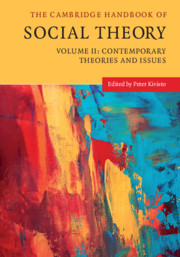Book contents
- The Cambridge Handbook of Social Theory
- The Cambridge Handbook of Social Theory
- Copyright page
- Contents
- Figures
- Tables
- Contributors
- Preface
- 1 Rational Choice Theory and Methodological Individualism
- 2 Network Theories
- 3 Cultural Sociology
- 4 Identity
- 5 Emotions Theory
- 6 Theorizing Sex/Gender: Feminist Social Theory
- 7 Intersectionality as Critical Social Theory
- 8 Modernity
- 9 Realism
- 10 Globalization: Not Good, Bad, or Over
- 11 Time/Space
- 12 Social Theory in the Anthropocene: Ecological Crisis and Renewal
- 13 Embodiment
- 14 Sexualities
- 15 Multiculturalism
- 16 Risk
- 17 Trust and the Variety of Its Bases
- 18 Unities Within Conflict: Mapping Biology’s Relevance to Sociological Theory
- 19 Civil Society
- 20 Social Movements: Sequences vs Fuzzy Temporality
- 21 Immigration
- Index
- References
3 - Cultural Sociology
Published online by Cambridge University Press: 03 December 2020
- The Cambridge Handbook of Social Theory
- The Cambridge Handbook of Social Theory
- Copyright page
- Contents
- Figures
- Tables
- Contributors
- Preface
- 1 Rational Choice Theory and Methodological Individualism
- 2 Network Theories
- 3 Cultural Sociology
- 4 Identity
- 5 Emotions Theory
- 6 Theorizing Sex/Gender: Feminist Social Theory
- 7 Intersectionality as Critical Social Theory
- 8 Modernity
- 9 Realism
- 10 Globalization: Not Good, Bad, or Over
- 11 Time/Space
- 12 Social Theory in the Anthropocene: Ecological Crisis and Renewal
- 13 Embodiment
- 14 Sexualities
- 15 Multiculturalism
- 16 Risk
- 17 Trust and the Variety of Its Bases
- 18 Unities Within Conflict: Mapping Biology’s Relevance to Sociological Theory
- 19 Civil Society
- 20 Social Movements: Sequences vs Fuzzy Temporality
- 21 Immigration
- Index
- References
Summary
Contemporary cultural sociology specifies the concept of culture by developing three core, irreducible, but compatible, theoretical elements: action, discourse, and cultural production. In doing so, the field has been influenced by a range of broader trends, including pragmatism, cognitive science, semiotics, hermeneutics, organizational theory, and field theory. Research in the subfield can be specified and understood as elaborations and syntheses of these different elements.
Action, cultural power, cultural production, culture, discourse, levels of analysis
Lyn Spillman’s research interests focus on economic and political culture, qualitative methods, and cultural theory. Her most recent publication is What Is Cultural Sociology? (Polity, 2020). She is Professor of Sociology at the University of Notre Dame.
Michael Strand is an Assistant Professor of Sociology at Brandeis University. His published work has appeared in Theory and Society, Sociological Theory, History of the Human Sciences, American Journal of Cultural Sociology, Science, Technology & Human Values, and Thesis Eleven. He is currently completing a book manuscript on social justice as a moral belief.
- Type
- Chapter
- Information
- The Cambridge Handbook of Social Theory , pp. 43 - 62Publisher: Cambridge University PressPrint publication year: 2020
References
- 2
- Cited by

